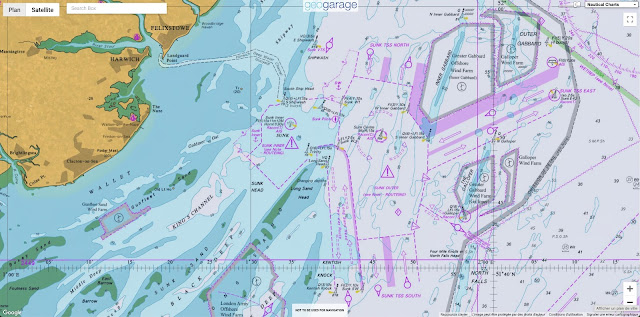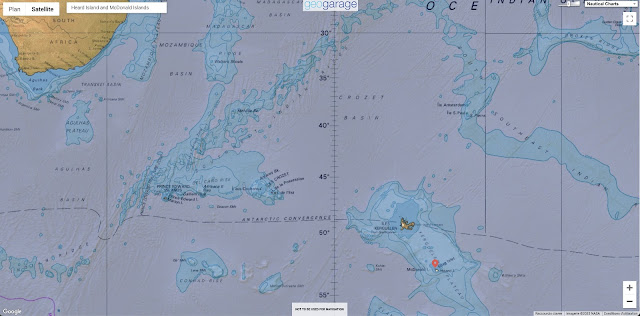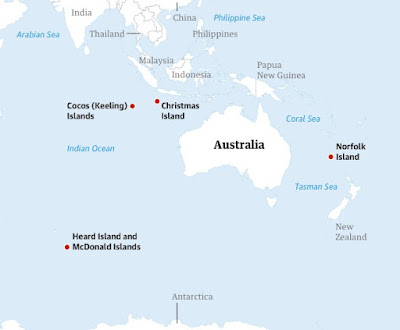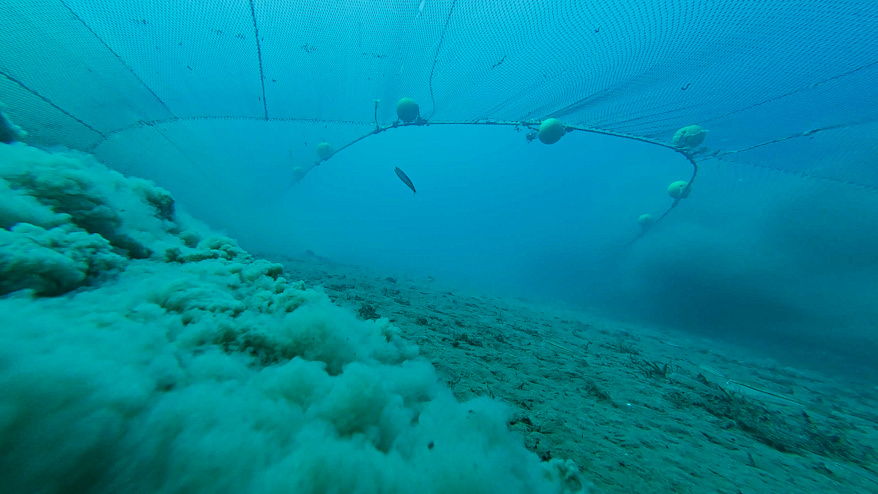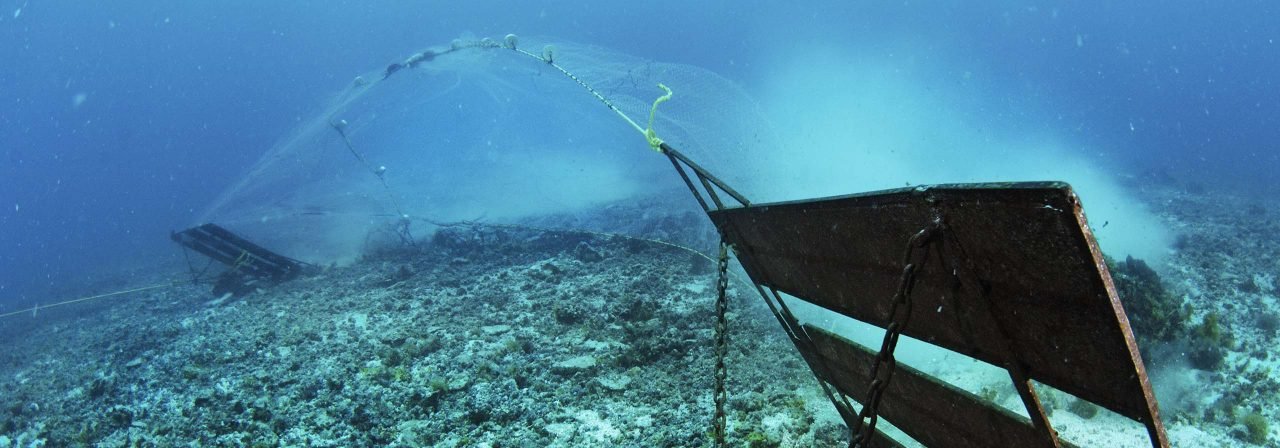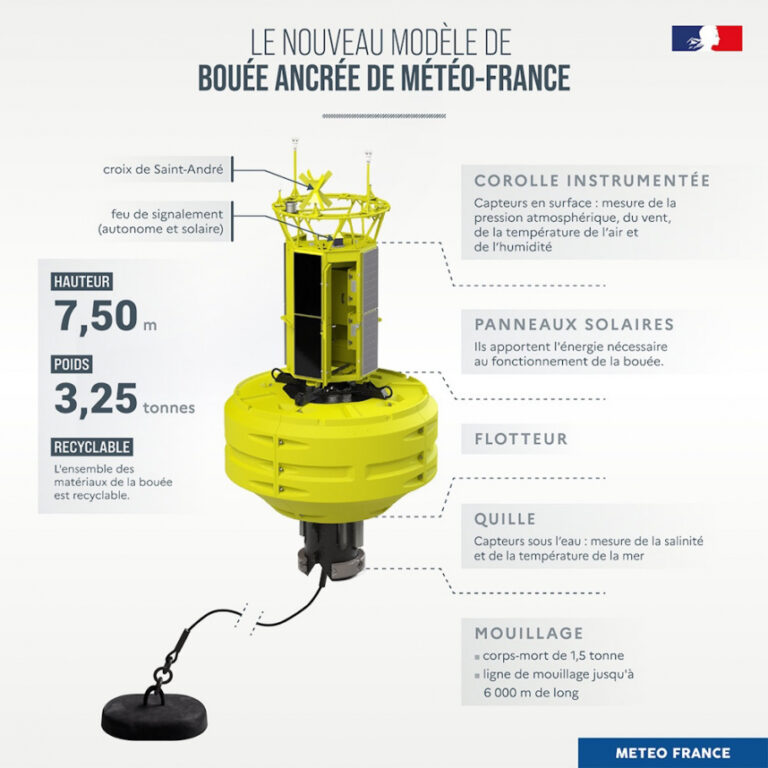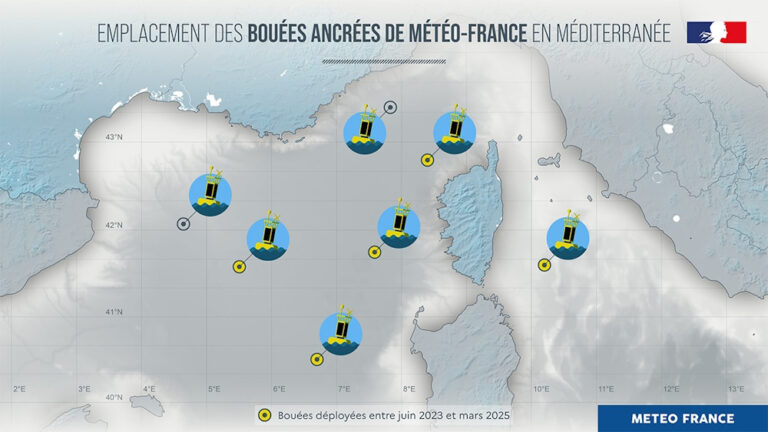Saturday, April 5, 2025
Fatal 2024 Sydney to Hobart | Gale force winds, 30 retired yachts (full race documentary)
Friday, April 4, 2025
Trump tariffs hit Antarctic Islands inhabited by zero humans and many penguins
The Heard and McDonald Islands are among the dozens of targets of President Donald Trump's latest round of tariffs.
But they have no exports, because no one lives there.
On Wednesday, President Donald Trump announced the US was imposing reciprocal tariffs on a small collection of Antarctic islands that are not inhabited by humans, as part of a global trade war aimed at asserting US dominance.
The Heard and McDonald Islands, known for their populations of penguins and seabirds, can only be reached by sea.
Additional countries—including the Heard and McDonald Islands, which are, incidentally, not countries—were listed on sheets of paper distributed to reporters.
One of the sheets claims that the Heard and McDonald Islands currently charge a “Tariff to the U.S.A.” of 10 percent, clarifying in tiny letters that this includes "currency manipulation and trade barriers." In return, the sheet says that the US will charge "discounted reciprocal tariffs" on the islands at a rate of 10 percent.
Their reported 37,000 hectares of land makes them a little larger than Philadelphia.
According to UNESCO, which designated the islands as a World Heritage Site in 1997, they are covered in rocks and glaciers.
Heard Island is the site of an active volcano, and McDonald Island is surrounded by several smaller rocky islands.
The islands are home to large populations of penguins and elephant seals.
The Australian Antarctic Division manages the islands, preserving the environment and conducting research on the large wildlife population, as well as climate change’s impact on Heard and McDonald’s permanent glaciers.
On Wednesday, Australia and a number of its island territories, including Christmas and Cocos Keeling Islands, were also hit with tariffs of 10 percent. Norfolk Island, which Australia also claims, got a tariff of 29 percent.
When reached for comment, the Australian Antarctic Division referred WIRED to the country’s Department of Foreign Affairs and Trade, which did not respond prior to publication.
"One could argue this is in breach of the international Antarctic spirit," Elizabeth Buchanan, a polar geopolitics expert and senior fellow at the Australian Strategic Policy Institute, tells WIRED.
However, Australia has claimed since 1953 that the islands are Australian territories.
Australia also laid claim to the water surrounding the islands via a 2002 act that established a marine reserve.
Last year, the country passed a law extending the boundaries of that reserve, approximately quadrupling its size.
The Australian Defense Force claims that the goal of Operation Resolute is to address "security threats" like piracy and pollution.
The Australian Antarctic Division claims that the area occasionally receives ships involved in scientific research, commercial fishing, and tourism.
- The Guardian : ‘Nowhere on Earth is safe’: Trump imposes tariffs on uninhabited islands near Antarctica
- DailyMail : Critics mock Trump tariffs on 'penguins' living on uninhabited Antarctic Islands
- Reuters : Tiny Australian outposts, including some with no people, targeted by Trump tariffs
- CNN : An uninhabited island, a military base and a ‘desolate’ former whaling station. Trump’s tariffs include unlikely targets
Thursday, April 3, 2025
Bottom trawling in European waters costs society up to €11bn a year, new study finds
The three-part study - which included building a predictive map of carbon stocks across Canada’s continental margin - reinforces that the seabed is vital for both carbon storage and marine ecosystem health. Yet, it’s frequently overlooked in current marine protection planning.
With growing momentum around seabed carbon protection, this study underscores the urgent need for detailed mapping to inform marine planning and ensure collaborative, sustainable management of our ocean environment.
From EuroNews
Ocean experts found that the economic costs mostly come from carbon emissions caused by churning up the seabed.
Bottom trawling in European waters costs society up to €10.8 billion each year, according to a first-of-its-kind study released today.
It found that this cost is largely due to carbon dioxide emissions from disturbed sediments on the seafloor.
“We discovered recently that bottom trawling, by churning up the sediments on the seafloor, releases CO2 on the scale of global aviation and that half of those underwater emissions will end up in the atmosphere,” explains Enric Sala, National Geographic Explorer in Residence and one of the authors of this report.
Bottom trawling is a destructive fishing practice which involves dragging a net - some so large it could fit a Boeing 747 plane - across the seafloor to catch fish.
So, he says, for the first time they decided to calculate the costs and benefits of this fishing practice to both the industry and society at large.
What is the cost of bottom trawling in Europe’s waters?
The study is the first to measure the full economic cost of bottom trawling in European waters - including the EU, UK, Norway and Iceland.
It shows that this damaging fishing practice imposes somewhere between €330 million and €10.8 billion in annual costs to society.
The range of estimates in the study is so large because there is no globally agreed value on the cost of a tonne of carbon.
While bottom trawling does support jobs across the continent, bringing in both a source of food and revenue, the study’s authors say climate costs, environmental impacts and issues for small-scale fishermen outweigh these benefits.
Forbidding this fishing practice in marine protected areas (MPAs), they add, would benefit marine life, the climate and even the fishing industry.
Small-scale, sustainable fishers are seeing their livelihoods ripped away along with the reefs and seagrass meadows that are bulldozed by the weighted nets.
Hugo Tagholm
Executive director of Oceana UK
“Small-scale, sustainable fishers are seeing their livelihoods ripped away along with the reefs and seagrass meadows that are bulldozed by the weighted nets,” says Hugo Tagholm, executive director of Oceana UK.
“And all this to line the pockets of a few. The truth is that thriving marine wildlife supports flourishing coastal communities.”
Bally Philp is the national coordinator for the Scottish Creel Fishermen’s Federation which represents small-scale, inshore fishing vessels, line fishing vessels and hand-diving vessels.
“These are some of the most low-impact and highly selective fishing methods,” he explains.
Philp says that types of gear are often mutually exclusive.
If you were to restrict trawling in the area three miles from the Scottish coast alone, he adds, the country could double its number of fishermen and the amount of revenue generated by fisheries.
“We could do it without catching an extra fish.”
The study’s authors also point out that European taxpayers are funding the destruction of their own oceans.
European governments spend an estimated €1.3 billion on subsidies for bottom trawling every year, they say, a figure that is nearly equivalent to the value of the jobs the industry creates. Italy, Norway, Denmark, Great Britain and Sweden offer the highest amounts.
In some countries, researchers even found that bottom trawling wouldn’t be profitable for the companies doing it without these subsidies.
“Our analysis found that society always loses to industry when it comes to bottom trawling. Industry makes a profit only because it externalises its cost,” Sala says.
Citizens pay the cost of government subsidies which come from taxpayers’ hard-earned money.
Enric Sala
National Geographic Explorer in Residence and one of the authors of this report
In France, says director of NGO BLOOM Claire Nouvian, the government has been subsidising trawling for decades.
Research from BLOOM and French researchers from L’Institut Agro and the French Natural History Museum has found that around 800 French bottom trawling vessels destroy roughly 670,000 square kilometres of seabed each year - an area bigger than France itself.
Despite what Nouvian calls the country’s “love affair” with this destructive fishing practice, President Emmanuel Macron is convening the SOS Ocean summit at the end of March in Paris.
Ahead of these events, Macron announced €700 million for the fishing industry to modernise its fleets, strengthen food sovereignty and more.
“The trawling lobby was blasting with joy, they were so happy,” Nouvian claims.
Redirecting subsidies away from trawling could provide a pathway for financing a fair transition for the fishing industry, according to the report.
The study comes as a coalition of civil society organisations calls for governments in Europe to ban bottom trawling in MPAs.
These areas are meant to be safe havens for marine life but around 13 per cent of Europe’s bottom trawling happens within their borders - a figure that rises to 20 per cent in the EU.
“The solution is obvious. Let's start by eliminating bottom trawling in marine protected areas and not relocating that effort elsewhere,” Sala says.
“That will work for marine life, the climate and society at large. It would also allow marine protected areas to fulfil their goal to protect marine life, and eventually help replenish nearby fishing grounds.”
EU member states are already supposed to be working to phase out bottom trawling in MPAs by 2030. So far, Greece and Sweden are the only countries to have announced bans or strong restrictions.
The bloc’s nature laws and international biodiversity commitments bind member states to rigorously protect these supposed safe havens for marine life.
“A proper interpretation of the Habitats Directive would mean that bottom trawling should already not be tolerated in EU Marine Protected Areas,” says John Condon, wildlife lawyer at ClientEarth.
“We heard from Commissioner Kadis (Costas Kadis, European Commissioner for Fisheries and Oceans) this month that he is committed to the full enforcement of our nature laws - which we hope means we can expect bottom trawling to be conclusively phased out of EU MPAs designed to protect seabed ecosystems.”
But a recent analysis from marine NGOs Oceana, Seas At Risk and ClientEarth found that no EU country has comprehensive plans to phase out destructive fishing practices in MPAs by the end of the decade.
More than half failed to submit a roadmap.
As a result, the coalition of marine NGOs is taking governments to court in France, Germany, the Netherlands, Spain and Sweden for infringing EU nature laws by failing to protect their MPAs against the impacts of bottom trawling.
Links :
- Ha-Shilt-sa : Study suggests seabed sediments should be considered for protection
- Euronews: NGOs and fishermen call for urgent action to end bottom trawling in marine protected areas / Greece becomes the first country in Europe to ban bottom trawling in marine protected areas / Why is France protesting a UK ban on bottom trawling in protected areas?
- National Geographic : Study: Bottom Trawling in European Waters Costs Society up to €11 Billion Annually
- Greenpeace : What is bottom trawling and why is it bad for the environment?
- CleintEarth : What is bottom trawling? How it works and environmental impact
- Mongabay : Lawsuit is latest push to curb bottom trawling in protected European waters
- For The Ocean : why we need an urgent bottom trawling ban across all protected waters in the uk and eu
- The Guardian : Bottom trawling: how to empty the seas in just 150 years
- Phys : Bottom-trawling techniques leave different traces on the seabed
- Nature : Long-term carbon storage in shelf sea sediments reduced by intensive bottom trawling
- BLOOM publishes red list of destructive ships / Ouest France: fishermen see red with Bloom's list
- GeoGarage blog :
Carbon released by bottom trawling 'too big to ignore', says ... /
Illegal bottom trawling in the Mediterranean: A threat to marine life and livelihoods in Tunisia /
Europe's fishing industry to battle with conservationists ... /
Bottom trawling releases as much carbon as air travel ... /
Getting to the bottom of trawling's carbon emissions /
Fishing industry still 'bulldozing' seabed in 90% of UK ... /
Fishing technique flattens the seafloor /
How a vampire squid inspired a Goldman prize-winning marine ... /
High seas fishing isn't just destructive—it's unprofitable
Wednesday, April 2, 2025
Meteo France : last developments
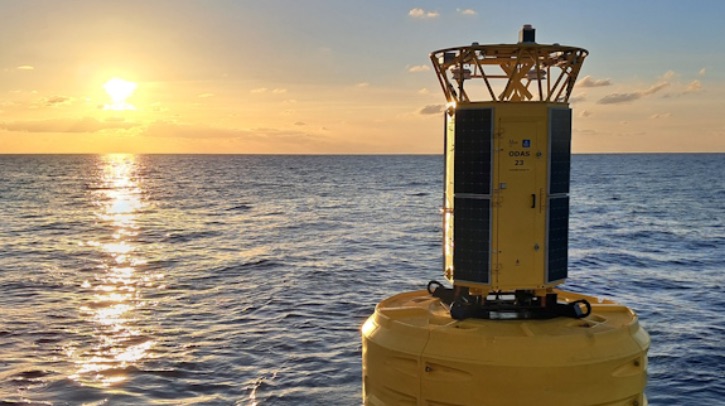
From Meteorological Technology Int. by Elizabeth Baker
On March 5, 2025, Météo-France launched the fifth in a series of meteorological buoys on the western front of the Mediterranean, northwest of Corsica.
This deployment forms part of the organization’s plans to strengthen its sea observation system, which began in June 2023 with the deployment of the first of the five anchored meteorological buoys, and is intended to improve the local ability to anticipate extreme weather before it arrives on land.
The meteorological buoys were financed mainly by the Ministry of Ecological Transition, Biodiversity, Forestry, Sea and Fisheries, via the Directorate-General for Risk Prevention (DGPR).
The services of the Directorate-General for Maritime Affairs, Fisheries and Aquaculture (DGAMPA) has entrusted the support of the launch and withdrawal operations to the Interregional Directorate of the Mediterranean Sea (DIRM MED) and the Lighthouse and Beacon Equipment Agency.
Météo-France will ensure the assembly, preparation, operation and maintenance of these buoys.
The anchored buoy is a meteorological measuring instrument with a floating structure, installed in the open sea.
It is equipped with two independent weather stations, powered by solar panels.
Its frame is formed by a yellow float, a steel keel and a mast on which sensors are fixed.
The buoy is up to 7m high (half of which is submerged) and weighs more than three tons, and its anchor line can reach 6km deep in the sea.
The anchored buoy makes it possible to measure and transmit in real time meteorological parameters such as wind, air temperature, atmospheric pressure and air humidity, but also oceanographic parameters (such as the height or frequency of waves and temperature and salinity of the sea).
These measurements are recorded by sensors.
The data is transmitted live and fed into various numerical models which are used by Météo-France forecasters.
Can you tell me a bit more about the technological design of the deployed buoys?
These five buoys are innovative models.
They feature a closed structure at the top of the buoy to protect the electronic core of the station and facilitate its maintenance, either on a boat or directly at sea on the buoy.
Working conditions are therefore secure.
They also present a logistical gain as the anchored buoy is now transportable inside a standard container.
Additionally, it features eco-responsible materials as a core part of its design, including empty float, food plastic, ultra-resistant and recyclable elements.
Why has the sea observation system been strengthened?
To make its forecasts, Météo-France relies on observations.
The latter are rare off the coast.
Weather satellites partially make up for this, radars do too, but they limit their maritime observation to direct proximity to the coasts (this is the case for precipitation, for example) and not to the surface of the sea.
Similarly, some boats carry out some meteorological measurements, but unfortunately, there aren’t enough of them and they need to avoid areas where activity is dangerous.
The deployment of five buoys in the Mediterranean therefore aims to improve coverage in surface observations at sea in this region, and to improve weather monitoring and immediate forecasting (such as the arrival of a thunderstorm).
During dangerous meteorological events, such as a thunderstorm or a Mediterranean episode, the data transmitted by the buoys will be essential when the weather scenarios diverge on the intensity and location of the phenomenon.
The data transmitted in real time will make it possible to confirm or rule out a scenario and to re-track the episode on the basis of proven observations.
The first buoy deployed in June 2023, for example, provided important information during violent thunderstorms that circulated on August 27 and 28, 2023, in the Mediterranean.
The scenario chosen by the forecasters predicted that the storm would pass south of Corsica, with violent gusts expected on the island.
The data transmitted by the buoy during the advance of the storm confirmed the trajectory and its intensity.
An orange thunderstorm warning had been issued for Corsica.
The data from the buoys also made it possible to better understand the strong episodes that affected Corsica in the autumn of 2024 and were a valuable help for estimating the risk in the Provence-Alpes-Côte d’Azur area.
This was the case, for example, between October 15 and 18, 2024, during a stormy deterioration that gave very large accumulations of rain over a large part of the territory, leading to sometimes devastating floods, especially in the southeast quarter where six departments had been placed on red alert for rain-flood and/or floods on Thursday, October 17.
Similarly, the reinforcement of the buoys proved useful during the Mediterranean episode from October 24 to 27, 2024.
This episode was distinguished by its duration and the gradual accumulation of precipitation over several days.
The coastal departments were the most affected, especially the Var and the Alpes-Maritimes.
Links :
- Météo-France recently launched a call for tenders to renew its two supercomputers, Belenos and Taranis.
The objective is to improve the reliability of forecasts, better anticipate high-stakes phenomena, more precisely simulate the future climate and support actions to adapt to climate change. - Meteo Tech Int : NPL and MSL detect earthquakes in Pacific Ocean using pioneering detection technique / How are NOAA’s latest buoys tackling ocean acidification?
- SailWorld : The IMOCA sailors - key contributors to global oceanographic science
Tuesday, April 1, 2025
Media outlets sunk by April fool's prank of the Navy's new "Caterpillar drive" stealth submarine
From The Debrief by Tim McMillan
Naval News, a reputable source for maritime news, published a seemingly groundbreaking article claiming the U.S. Navy was outfitting its Virginia class submarines with a revolutionary magnetohydrodynamic drive, or “caterpillar drive,” that “promises to make the submarine virtually undetectable.”
“Submarines use stealth to dominate the seas, presenting an illusive yet deadly threat,” the Naval News article reads.
“Now U.S. Navy submarines will take stealth to a new level. American submarines will now be fitted with magnetohydrodynamic drive.”
Unfortunately, several niche media sites that later circulated the story didn’t realize they were sharing a concept straight from fiction.
Specifically, Tom Clancy’s Cold War thriller “The Hunt for the Red October,” where a stealth submarine equipped with a magnetohydrodynamic drive is a crucial plot element.
The prank showcased the fine line between fact and fiction and served as a stark reminder of the importance of critical media consumption in the digital age.
In fairness, given the nature of today’s technological progress, which frequently resembles science fiction, it’s understandable why some could be misled by Naval News’s seemingly credible announcement.
In recent years, engineers have been exploring the potential of plasma propulsion engines using magnetohydrodynamics for space exploration.
The goal is that a magnetohydrodynamic drive would offer a more continuous propulsion system than traditional chemical rockets.
Furthermore, since the 1960s, scientists and military researchers have been studying the use of magnetohydrodynamic drives for submarine propulsion.
This technology leverages the magnetic properties of water to move the submarine forward, thereby eliminating the need for moving parts, such as traditional propellers.
Another kernel of truth from the Naval News article is that the U.S. Defense Advanced Research Projects Agency (DARPA) is currently attempting to develop a workable magnetohydrodynamic drive under its “Principles of Undersea Magnetohydrodynamic Pumps” or “PUMP” program.
However, the concept remains largely theoretical, and the leap from experimentation to an operational caterpillar drive , especially in the context of creating a “stealth submarine,” is a significant one.
The idea of a completely stealth submarine, undetectable by enemy forces, has been a coveted goal for global navies and could justifiably be considered the “Holy Grail of naval warfare.”
The concept of a magnetohydrodynamic-drive stealth submarine was popularized in the 1990 film adaptation of Tom Clancey’s literary spy thriller “The Hunt for the Red October.”
Due to its lack of moving parts, a magnetohydrodynamic-driven submarine would theoretically significantly reduce noise levels, a key advantage in underwater stealth.
However, a magnetohydrodynamic drive wouldn’t make the vessel completely silent, nor would it result in a fully stealth submarine.
The electric currents required to generate the magnetic fields for a magnetohydrodynamic-driven submarine would produce detectable gasses and noise.
The magnetic fields produced by the MHD would likewise create a distinct magnetic signature that could be easily traced by modern anti-submarine warfare (ASW) technology.
Moreover, contemporary anti-submarine warfare has evolved to include a range of detection techniques beyond just listening for the sounds a submarine makes.
Today, leading sub-detection methods include measuring temperature gradients in the water, variations in the Earth’s magnetic field caused by a sub’s large metal hull, thermal imaging, chemical sensors, and airborne LIDAR that can identify changes in water depth or disturbances.
In short, a magnetohydrodynamic drive would not suddenly render a sub “stealth,” as The Hunt for the Red October or Navel New’s prank article implies.
Nevertheless, this didn’t stop a handful of publications from spreading the fictitious word about the Navy’s supposed leap in stealth submarine technology.
One of the outlets that aggregated the story was Marine Insight.
“World’s No. 1 complete maritime information website,” the “About” page reads on Marine Insight’s website.
“Since 2010, Marine Insight has been informing and educating people around the world about the maritime industry.”
Marine Insight has since removed the article about the fictitious magnetohydrodynamic drive.
However, the headline “U.S. Navy Unveils World’s First Submarine Equipped With Silent Caterpillar Drive” still populates under the site in Google News.
A YouTube channel called “Military Defense News” published a nearly three-minute video of a computer voice program reading the article, complete with still images of U.S. submarines and dramatic background music.
A Ukrainian news site, GaGadget, even added details not contained in the original article.
“The submarine’s appearance and characteristics are currently being kept secret, but it is known that the propulsion system is located inside the hull, which means there is no traditional propeller,” GaGadget’s Mykhailo Stoliar wrote.
The fictitious article was mainly shared by social media-only “news” sites, with varying follower counts ranging from a few hundred to tens of thousands of followers.
Aside from the article’s publication date, April 1st, some seemingly overlooked clues should have called to question claims of the U.S. Navy subs being outfitted with new stealth propulsion drives.
Most prominently, editors posted, “Important update on this article: April Fool’s” at the beginning of the article.
Less obvious, the article notes that the Virginia-class attack submarine, the USS Montana (SSN-794), was expected to conduct sea trials with the new caterpillar drive on the Penobscot River in Maine.
In Clancey’s fictional spy thriller, Soviet sub-captain Marko Ramius stealthily navigates the Red October to the Penobscot River to defect to the United States.
It’s important to note that the fictitious story caught traction primarily among smaller, niche publications rather than mainstream media.
The incident underscores the critical need for media consumers to question and verify the sources of their information, particularly in an era where fly-by-night “news” outlets can easily and rapidly spread sensational claims thanks to social media.
Ultimately, Naval News’s April Fool’s joke served as a humorous reminder of the enduring allure of stealth technology in naval warfare and the importance of skepticism and due diligence in news consumption.
Monday, March 31, 2025
New report predicts how climate change and illegal fishing could threaten global ocean
From PewTrusts by Kevin He and Gina Flore
Shifting fish populations, territorial disputes and conflicts among fishers likely to strain policymaking
The global trade in fish is big business, worth upwards of $400 billion per year.
Healthy fish populations are also a particularly strong contributor to nutrition and livelihoods in coastal communities from regions such as Africa, Asia and the Pacific Islands.
Unfortunately, in areas around the world, this major source of revenue is increasingly threatened by climate change and illegal, unreported and unregulated (IUU) fishing.
To better understand how these threats could shape the future of fisheries globally, Pew commissioned the Royal United Services Institute (RUSI), an independent defense and security research think tank, to identify issues at the intersection of climate change and IUU fishing that will require concerted attention by governments, nongovernmental organizations and other partners in the next 10 years.
This type of project, known as a horizon scan, is a collaborative research method used for surfacing threats and opportunities.
In this first horizon scan of climate change and IUU fishing, RUSI and a group of external experts identified 20 emerging issues, under the following four themes, which could affect fisheries-related policymaking for decades to come.
Management and supply chains will struggle to keep up with shifting fish populations
Nearly half of the fish stocks that are shared among two or more countries are shifting their ranges due to climate change.
However, most management structures, such as regional fisheries management organizations (RFMOs), are responsible for static geographies and the species that have historically called these places home.
Because RFMOs and other decision-making bodies may have no precedent or mandate for managing stocks as they shift, gaps in governance of these populations could emerge.
These gaps may emerge most dramatically in the Arctic and Antarctic, where climate change is causing rapid and dramatic changes to ecosystem boundaries.
These shifts, in combination with changing consumer demands, the extended range of vessels that transship catch, and new access to waters due to sea-ice melt, will create even more opportunities for IUU fishers.
Shifting fish stocks have other implications, including for artisanal and other small-scale fishers who may butt up against industrial fleets that are following target species into new locations.
These encounters could be benign or even mutually beneficial, especially if the fleets are able to trade equitably with each other and identify new market opportunities, or they could lead to exploitative dynamics, wherein industrial vessels take advantage of their larger capacity and market access to dictate less advantageous conditions for coastal communities.
The encounters could even devolve into violent conflict.
The fish population shifts could also result in longer seafood supply chains—for example, if consumers expect access to certain species even after it has moved into less accessible waters—potentially raising the risk of laundering or other illegal activities.
Defining boundaries in the ocean is harder with climate change
Delineating boundaries in the ocean can be a politically fraught exercise, and climate change is likely to add complication.
By treaty, a country’s waters end and the high seas begin 200 nautical miles from shore.
Rising sea levels, however, may shrink or entirely submerge low-lying islands, altering historically valid claims.
This dynamic is likely to play out most contentiously in the South China Sea, where overlapping territorial claims are made by China; Taiwan, Province of China; Vietnam; the Philippines; Brunei; Indonesia and Malaysia.
Each country seeks to lay claim to valuable resources in the water and beneath the seabed, and these governments often base their right to do so on their ownership of uninhabited, low-lying islands.
These existing geopolitics, when combined with depleted fish stocks and significant overcapacity of fishing fleets, may spark violent conflict as water levels rise and territorial claims become murky.
In addition, inconsistent enforcement of territorial waters and marine protected areas within those waters could lead to more disputes and may even allow IUU fishing to thrive.
This is likely to occur most often in locations, such as the high seas, with unclear or developing governance structures where it is unclear who is responsible for specific areas of the ocean.
Climate change could make fishers more likely to bend or break rules at sea
As climate change pushes fish further from their traditional habitats, fishers who had traditionally relied on those stocks may turn to IUU activities for revenue and food, and there could be a demonstratable increase in the amount, and sophistication, of fishing-related organized crime.
With an increase in risk-taking comes potential backsliding of safety and labor precautions.
Legal and IUU operators alike could cut costs in the face of declining catch.
When coupled with increases in extreme weather events, this backsliding could make life at sea much more dangerous.
Climate change could spur action to better fight IUU
The global fisheries management community is not prepared for a warming future.
The current system is rife with gaps in governance and oversight, particularly related to international coordination and vessel identification and monitoring.
Moreover, there is no systematic way to track and evaluate interventions against IUU fishing.
Stronger efforts from civil society stakeholders and governments to increase the transparency of vessel ownership and access agreements for fishing across national borders could help fisheries managers better prepare for climate-related changes.
The horizon scan also pointed to the importance of weaving IUU fishing into other policy discussions, such as the global push to invest in climate adaptation.
For example, upgrades to infrastructure at ports to improve climate resilience could either unintentionally increase market access for IUU actors—for example by making it easier to hide illegal fish by mixing it with legal catch—or could be an opportunity to support transparency and disrupt IUU activities.
The RUSI horizon scan on IUU and climate change is a seminal piece of work and could affect policymaking for years to come.
While some of the highlighted issues may never materialize, RUSI has demonstrated how climate change will touch every aspect of ocean management—including legal and IUU fishing.
It is now up to governments and international bodies to do the hard work of ensuring that climate change does not allow illegal activities to make sustainable fisheries even more difficult to achieve.
Links :
- World Economic Forum : Why illegal fishing must be stamped out on environmental and humanitarian grounds
Sunday, March 30, 2025
SP80 breaks the 50-knot barrier, stepping closer to the World speed record
The kite-powered SP80 has achieved a new top speed of 51 knots in Leucate, France, taking them one step closer to their stated aim of beating the world speed record before summer 2025.
To achieve the record, the SP80 team is pinning their hopes on the engineering behind the boat. It has a custom-designed foil, which the team says is built to propel it past 150 km/h.

‘This run above 50 knots allowed us to finally observe the behaviour of our foil in a speed range that remains largely unexplored in the world of sailing,’ explains Benoît Gaudiot, the kite pilot aboard SP80.
‘We deliberately slowed the boat down just before reaching 52 knots as a precaution, but our analysis of the data indicates that it did not encounter any major barriers. This is extremely promising for the future!’
‘The boat is now close to its full technical potential,’ explained SP80 pilot Mayeul van den Broek.
‘The challenge for Benoît and I now is to sail as much as possible to master the boatʼs behaviour from 0 to over 70 knots. We need to fine-tune our trajectories, improve our synchronisation, and push the machine even further.’

‘Since the boatʼs relaunch at the start of 2025, the weather has not always been favourable, with winds often too light to accumulate significant sailing hours. But with each outing, we can feel it the logistics are running smoothly, the boat wants to go faster… all we need now is more time on the water to unleash its full potential!’
The SP80 journey
The team behind SP80 started in 2017 when one of the three founders Benoît Gaudiot, built super-ventilated fins for a kiteboard.
Another founder, Xavier Lepercq, built a simulation tool and began developing designs.

In 2020, they tested a prototype on Lake Geneva and, in June 2021, began building the entire boat at Persico Marine.
By 2022, the SP80 team planned to challenge the record in the south of France early in 2023, and Paul Larsen was looking forward to it.
Hitting 50 knots is undoubtedly an impressive feat for the SP80 team.

However, there are 25 knots of average speed before bettering Larsen’s record and becoming the world’s fastest boat.
The SP80 team hopes their first official record attempts will take place this spring at their base in Leucate, Occitanie.
